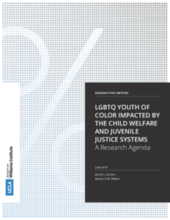Displaying 801 - 810 of 2214
This article from Marquette Law Review focuses on how children and parents interacting with the child welfare system in the US experience the removal process, the genesis of a foster care case.
This report from t he Williams Institute is a collection of working papers focused on understanding what we know and what we need to better understand about the lives and outcomes of system-involved youth who are both LGBTQ and racial/ethnic minorities, including those involved in the US child welfare system.
This paper from the Alliance for Child Protection in Humanitarian Action summarises findings from an initial scoping study, which seeks to review how child protection outcomes are captured when monitoring multi-purpose humanitarian cash programmes. The paper proposes a theory of change of the possible links between cash and child protection to inform the development of a monitoring strategy, including hypotheses that humanitarian cash might contribute to prevention of family separation, reduction of family violence, and supporting foster and temporary caregivers to care for separated and unaccompanied children.
This paper presents the current vulnerabilities faced by children and the scenario of child protection in India. While discussing the legal provisions prevailing in the country, it sheds light on the socio-cultural barriers that are creating resistance within the society in making the Alternative Care model (and the process of deinstitutionalisation of children) a success. Lastly it suggests viable options that may be helpful for the same.
This study extends the research on the experiences and outcomes of siblings in care by comprehensively mapping sibling networks both within and outside the care system and measuring sibling estrangement (living apart and lack of contact) over time among children in Scotland.
The aim of this study is to compare the subjective well-being (SWB) of children hosted in institutions and in foster families with the well-being of children living with their families. Results indicate that children in residential care have a lower SWB in all variables compared to foster care and general populations groups.
This mixed method study explores the postsecondary experiences of foster alumni in a large southwest urban area of the US.
The purpose of this study is to confirm whether the effectiveness of the program is sustainable 9 months after project completion for the children and adolescents participating in a childcare and rehabilitation support project.
This country care review includes the care-related Concluding Observations adopted by the Committee on the Rights of the Child.
In this article, the authors present findings from a follow‐up assessment from the Bucharest Early Intervention Project (BEIP) - the first longitudinal study to investigate the neurodevelopment of institutionalized infants randomized to a foster care (FCG) intervention versus care as usual (CAUG)- of brain electrical activity as indexed by resting EEG at age 16 years.



